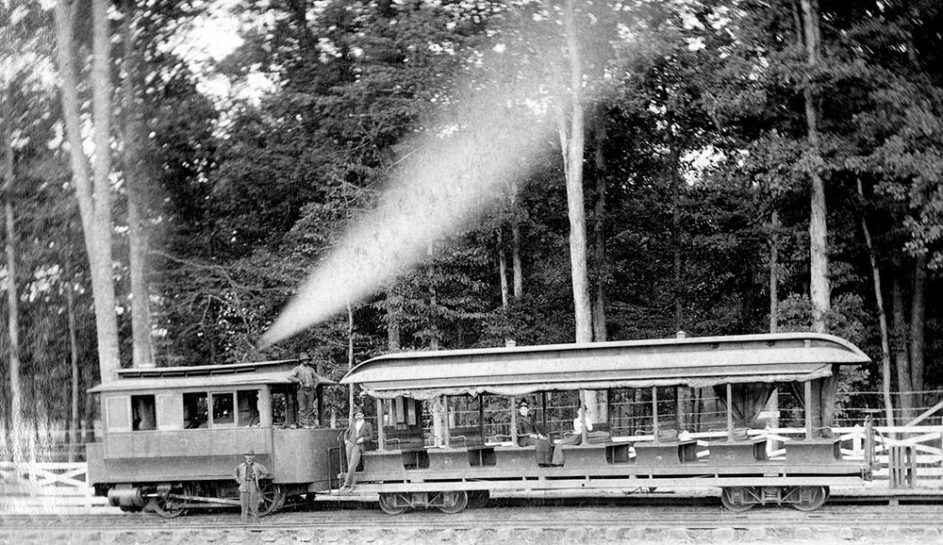Perhaps the most eventful year in Fountain City’s history was the year 1890. That was the year that the U.S. Post Office decided Tennessee could not have two Fountain Heads, so the one in Sumner County kept the name and Fountain City was born.
A prominent real estate developer from Lexington, Kentucky, purchased 431-acres in the heart of Fountain City at a cost of $159,600 (the equivalent of over $4 million in today’s dollars) and an additional 14-acres and the Fountain Head Hotel itself for $27,500. Col. J.C. Woodward soon began to enhance the hotel and resort and added the lake in 1894. And, it was the year that another group of investors began construction of the Fountain Head Railway.
The Fountain Head Railway Company was granted a charter in November 1889. Early in 1890 ground was broken for the 5.25-mile track from Central Market (now Emory Park) to Fountain Head (now Fountain City). The railway, which came to be known locally as the Dummy Line, was ready for business on May 27, 1890, in the record time of five months.
One motivation for the Dummy Line was the increasing demand for “rapid transportation” to the Fountain Head campground with its crystal-clear spring and the beautiful grove of trees surrounding it. Its construction transformed the farming hamlet into Knoxville’s most popular resort. The “pure and magnificent air,” dancing pavilion and picnic area made it a favorite among the city’s residents.
The Fountain Head Improvement Company had built a 40-50 room hotel overlooking the park and a real estate company was promoting the sale of residential lots in the suburb. Advertisements in the papers promised pure water, beautiful trees, a pleasant climate and easy transportation. By the spring of 1891 many prominent Knoxvillians were building homes near the park, including John W. Hope, the jeweler; Col. J.C. Williams, coal magnate; Sol George, department store owner; W.T. Hall and others.
By 1891 the Fountain Head Railway Company owned three engines, seven passenger cars and four freight cars. The trains ran on regular schedules from 5 a.m. to 8 p.m. except on special occasions when they were run until midnight to accommodate late events. There were 23 stops between the Central Market and Fountain Head and the round trip took one hour at a speed of 35 miles per hour. The fare was five cents from Knoxville to Arlington, 10 cents to Fountain Head and 15 cents for a round trip. Sometimes 10,000 fares were collected in a day. Those working in textiles in the Baxter Avenue area, many railroad employees and those in retail and wholesale businesses downtown were able to commute to and from work daily.
The stops the Dummy Line made on the way to Fountain City were a mystery for years until an essay by Ralph Price and John Winkle was discovered. They were students in Nannie Lee Hicks’ American history class at Central High School in 1941-1942. Price and Winkle listed these stops: Central Market (Broadway at Holston, now Tyson Street), Munson (now Bernard Avenue), Dameron, Baxter, Anderson Station, Central, Mynder’s Station, Mucktown (now the site of the Broadway Shopping Center), Edgewood, Scott, Lincoln Park, Arlington, Sycamore (later Gentry Street), Appletree (or Clearview), Whittle Springs, Greenway, Smith’s (Smithwood), Conner’s Station, Woodward (or Gibbs Road) and Fountain Head.
Lucy Curtis Templeton’s Jan. 10, 1960, “A Sunday Country Calendar” in the Knoxville News-Sentinel described the circuitous route:
It left town from a station on the corner on North Broadway and Holston (now Tyson) Street, which runs along the northern side of Old Gray Cemetery. … After the “dummy” left the station in town it puffed along Holston Street past the National Cemetery, past the old General Hospital, then due north until it came to what is now Woodland Ave. The area was a true woodland then; there was only one stop in the lovely grove after leaving the Foster Scotts. This stop was at the home of Mr. Eugene Mynders, about midway between the turn into Woodland and the next bend, which was on a hillside above Mucktown and below the F.A.R. Scott’s large brick residence on top of the hill where St. Mary’s Hospital now stands.
After some semi-circling south here, the “dummy line” turned north once more, ran through Lincoln Park where there was a siding used to let one train pass another. … After leaving Lincoln Park, the line took a turn to the east, ran along what is now Walker Boulevard, and crossed Broadway at Arlington where there was a station. It then resumed its course along Walker Boulevard past the brickyard and then the Apple Tree Station on the McCampbell farm.
… The line then turned north again past Whittle Springs through a pleasant meadow to Greenway, where there was another station. … From this point, the “dummy” ran along the same route followed later by the streetcars and buses. … From Greenway it was a straight shoot to Fountain Head. It was not until years later that North Broadway was extended along what had been the old “dummy” line, although there might have been a side road there. The main highway ran to the right through Smithwood.
Although there are periodic suggestions that the original engineering drawings of the tracks are still out there somewhere, they have never been located. It would be interesting to determine whether the underpowered locomotive actually climbed a grade resembling that of nearby Harvey Street or whether a series of switchbacks permitted it to ascend the hill on which St. Mary’s Hospital once sat or merely skirted it. William Moyers, railroad historian, says that grade would rival that of the Southern Railway’s famous Saluda grade.
The steam powered dummy line gave way to more economical electric trolley cars in 1905. All that remained of the once popular steam railway was the memory.

